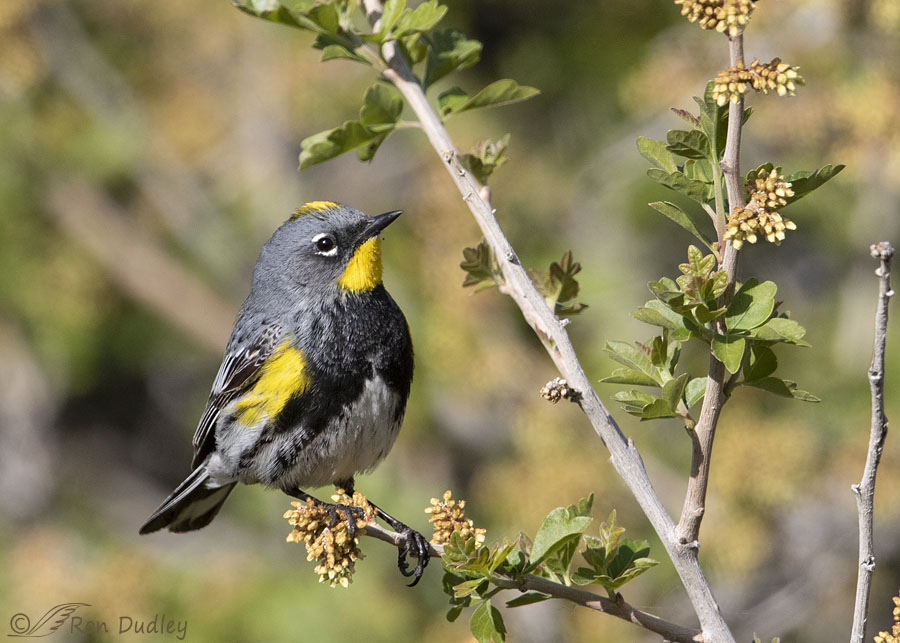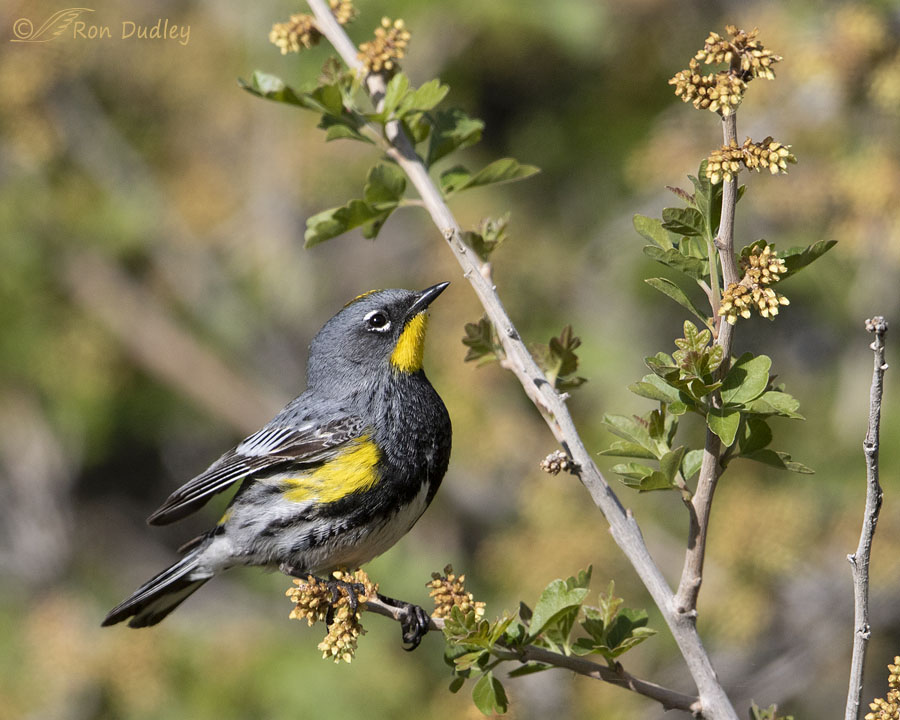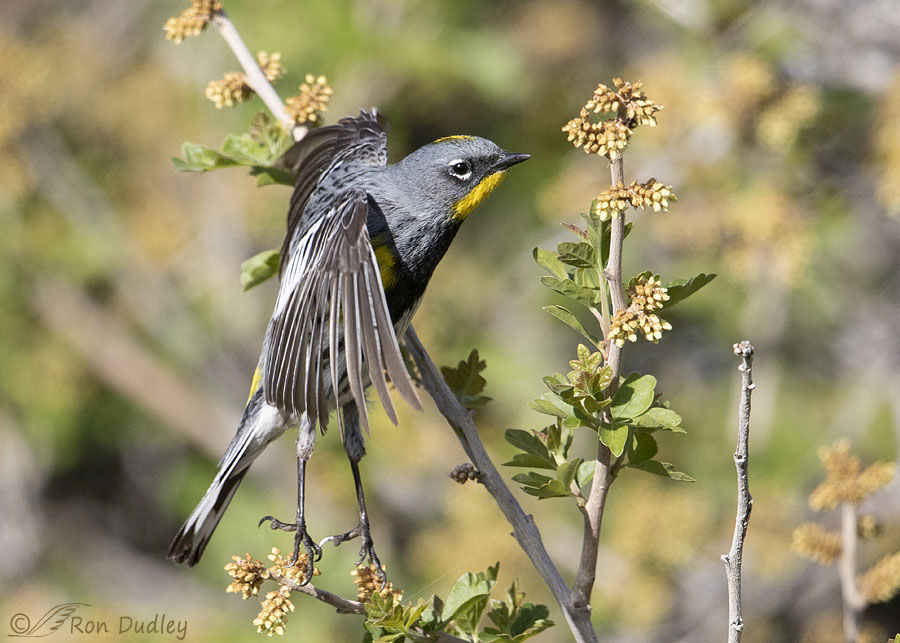Where there’s a will there’s a way, especially if you’re hungry, and even when there’s a significant obstacle to negotiate.
Yesterday morning I had pretty good luck with several songbird species at a migrant trap in a remote area of Box Elder County. Yellow-rumped Warblers were among them.

1/2500, f/6.3, ISO 640, Canon 7D Mark II, Canon EF 500mm f/4L IS II USM + EF 1.4 III Extender, not baited, set up or called in
And man oh man were they ever hungry! They were flitting around and hawking insects from this sumac bush at such a frenetic pace you’d have thought they were starving and maybe they were. After all, migration is nothing if it isn’t strenuous and extremely taxing.
Typically they’d land on an exterior twig of the bush like this one and then glance around frantically in all directions as they looked for tiny insects in flight nearby. When they located one they’d take off and snag it out of the air.
That’s exactly what this male is doing. He’s looking. Hard.

1/3200, f/6.3, ISO 640, Canon 7D Mark II, Canon EF 500mm f/4L IS II USM + EF 1.4 III Extender, not baited, set up or called in
Here he’s spotted a tiny flying morsel and he’s about to take off after it but there’s a problem. That largest branch in front of his breast is directly in his way so how would he negotiate it?

1/2500, f/6.3, ISO 640, Canon 7D Mark II, Canon EF 500mm f/4L IS II USM + EF 1.4 III Extender, not baited, set up or called in
He chose to use a wing-aided vertical jump to get over it before he shot off like a rocket after the tiny flying insect out of frame to our right.
He’s getting as much lift out of those long slender legs as he possibly can. All this happened in a flash, so quickly I didn’t even know what I’d captured until I got home and looked at my photos on the big screen.
Birds, especially little ones, are world-class athletes and I’m always delighted when I capture their lightening-quick gymnastics in my photos since I very often miss seeing or noticing them, even while looking through my super-telephoto lens.
As I often say it’s the little things that can make bird photos interesting.
Ron


Ha Ha, what a great stretch!
Ron,
I was going to ask what a “migrant trap” was as well but read EC’s post and your answer. Thanks.
A comment on your “specs” and the SS you use to catch this movement. There are some foxes (5-7 not counting pups that are still in the dens, by some reports) that live on some horse property behind my house. Some of the locals feed them every night which attracts the foxes and large crowds of people. Before you say it, I think of you every night that I go to observe the “Feeding of the Five Foxes” (just to give it a Biblical twist) and think of the phrase “Not baited, set up or called in.” It bothers me a lot but I do realize that I will not change anything by speaking up… but we are not doing the foxes or environment any service by throwing meat and other “garbage” in their direction. I even feel a little guilty taking pictures of the event, but…
I digress. I have used a SS of 2500 or more in the evening sunlight and still get motion blur from these little creatures and they aren’t moving anywhere near as fast as your little song birds. Frustrating, but with increasing frequency they are sharp. Just an observation. What percentage of pics do you discard in these rapidly moving situations? You seem to post a “complete” series quite frequently.
Curious,
Stephen
P.S. I have some great pictures of foxes… framed with guilt! No, I don’t feed them.
“What percentage of pics do you discard in these rapidly moving situations? ”
I’ll put it this way, Stephen. Easily less than 1% are ever posted to my blog. I keep about 10% of them but many of those are kept for reasons other than them being particularly good photos.
Regarding your fox story – shame on those people for feeding wildlife like that..They’re not doing the foxes any favors. With rare exceptions it’s a selfish and ignorant practice.
On the basis of this and recent posts, you need to add “leg stretching” to your tags.😉
I looked in an old book for info on this bird; used to be genus Dendroica. Sibley called it that in his 2003 edition but Setophaga in 2014. Then I looked at Cornell BotW site. Now my head hurts.
That’s bird classification for you, Lyle. New genetic info can really throw it into a tailspin.
‘Migrant trap’? I assume this is not a trumpian phrase but it is new to me.
What a stunning little athlete. I do hope that the got the prize (and lots of them).
EC, “migrant trap” is a term birders use for an area that attracts migrants (of the avian sort) during their long trip. Typically migrant traps have abundant food, water and natural cover.
Thank you. I had guessed something similar but needed to check.
World-class athlete is correct! He can definitely dunk! ;)🏀
Happy Birthday and I Hope that something extra special crosses your path today!
As an interesting coincidence, today’s Los Angeles Times “Saturday” section has an article on birding. 🦆🦅🦉
Happy Birthday!!! With all the appropriate emoticons I cannot create from here.
And many thanks for the gifts you give us each and ever day.
Thanks, Marty. I just had a birthday call from my best friend as kid growing up in Montana – that was pretty special.
And I hope you have a wonderful birthday tomorrow!
Beautiful spots of sunshine and your photos show them off so well.
I had a few in my yard this January and February.
Wow, April – that’s early. I don’t remember ever seeing them that time of year.
Great series Ron!
I think many animals, but especially birds have a quick mind and have the ability especially as they gain experience, to process situations, sightings and adapt very rapidly! Just like all animal populations, including humans, there also are those that don’t adapt quickly or who take chances at their and others risk. Just my take!
I agree, Dick. And those who don’t adapt contribute far fewer genes to the gene pool. Natural selection.
Yes, but I have a problem with humans short-circuiting natural selection in reference to wildlife. Anything more would get into too many pros and cons, so I’ll leave it.
Interesting bit along those lines on Smerconish this morning from a Dr. Vivek Murthy. …….
But it doesn’t work that way with Mother Nature. She is not a contestant on “The Apprentice.” She is just chemistry, biology and physics. We’re the contestants on her show. We don’t get to fire her. She gets to fire us.
She throws viruses, hurricanes, floods, droughts, heat waves and pandemics at us to sort out who’s the fittest. And the ones who survive have one thing, and one thing only, in common: They are the most adaptive at generating the chemistry, biology and physics needed to meet the challenge.
That’s all that matters. All those who can’t, get fired or, rather, are returned to the manufacturer.
“Nice” way of putting it! 😉
WOW! What an outrageously beautiful little jewel!
This series also harkens back to our discussion of contemplation. Whether rapid (instantaneous) or more leisurely, birds (and critters) have brains and considerable intellect and they know how to use it.
I grew up in a time when birds/animals were considered to be driven solely by instinct, that they had little to no intelligence and that we needn’t be bothered by those considerations. Remember when vets (especially older–in my perspective–country vets) thought it unnecessary to use anesthesia for surgeries because animals didn’t feel pain, an idea perhaps lingering from OUR Dark Ages? Certainly, they weren’t allowed in heaven, a place reserved only for us smart humans! Thinking back, that was probably my first big disconnect with organized religion–many more followed. ANYWAY, I think I’ve spent a large portion of my life railing against that idea since it’s always been blatantly obvious to me that ALL critters displayed considerable intelligence, despite that it was often different than ours, based on differing priorities, along with language and culture among their species.
As I ponder this tiny little warbler, I see the wheels and cogs of intelligence clicking right along, solving all sorts of mathematical equations. Granted, it’s about food acquisition, but that’s a high priority for all of us.
I’ve rambled on way too long. But suffice to say, it’s NEVER a good idea to utter the phrase “dumb animals” (or “just a redtail”) within my earshot. Just do NOT go there! LOL!
You make some interesting points, Laura. I agree with them but I do wish we had better ways of communicating with animals and evaluating what might be going through their minds in many situations.
Oh ABSOLUTELY Ron! If only we could decode their languages and communicate!!
Everything about that last shot is perfect ❤️
Some might argue with that, Diana but I do think it’s a fun and interesting photo.
Yes! A great athlete. Nice capture.
Thanks, Nancy.
I’m envious. They overwinter here, and then, just as they start molting into that gorgeous breeding plumage, they leave.
Then you’re missing something, Catherine. They’re stunning birds right now.
Love his white eye-shadow.
🙂
AMAZING what those skinny little legs can do! What a fun “capture”! 🙂 Must need a LOT of bugs to have the muscle/energy to do that…….
“Must need a LOT of bugs to have the muscle/energy to do that”
Especially considering how tiny they are. Those bugs were so small I never saw even one of them, with the naked eye or through my lens.
Excellent photos of one of my favorites. And remarkable that you can get those feet and legs so sharp. These guys and gals have been with us all winter, but have been leaving and replaced by the Yellow Warblers and the Lesser Goldfinches.
Everett, Lesser (and American) Goldfinches have been all over my feeder for almost a week now. The latter (males) are simply gorgeous in the morning sunlight.